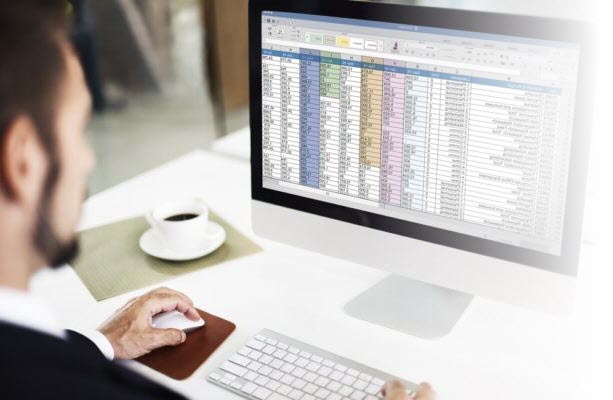| Public Courses | |||
| $440 | 1 Day Group discounts available |
||
| Times | 9:00am - 4:30pm | ||
| Reference | Hosted manual included or Purchase printed book |
||
| Certificate | Attendance or Completion upon assessment |
||
| Live Online |
Hands-on, Live Instructor Dedicated Training Platform |
||
| Private Courses | |||
| Classroom | Group Training (hired room) Get a Quote |
||
| In House | On your site Get a Quote |
||
Advanced Excel Courses
Learn advanced formulas, functions and types of financial analysis to be an Excel power user. Develop the skills to cleanse imported data from external sources, perform what-if analysis using Goal Seek, Solver and advanced Data Tables. Automate repetitive tasks using Macros and VBA. For a more comprehensive use of VBA, refer to our Excel Visual Basic Course outline.
We have 3 advanced level courses - each with a specific business focus.
Advanced Excel covers a broad range of advanced tools.
Advanced Excel Functions focuses on a variety of advanced Excel Functions
Excel VBA is a comprehensive course for those who are serious about automation of spreadsheets in Excel and across the Office applications
Advanced Excel
4.4 (2720 reviews)
$440
Brochure
Advanced Excel

This one-day advanced Microsoft Excel course is perfect for experienced Excel users who want to further develop their Excel skills to the peak of the software’s ability. This interactive course includes plenty of hands-on exercises to help you retain and start applying what you learn straight away in the workplace. You will learn advanced Excel skills like how to use advanced functions, PivotTables, Goal Seek & Scenarios, and basic automation with macros.
Improve your efficiency with Excel using a variety of advanced features
Use advanced functions to easily summarise data
Master functions to cleanse data to enable it be used with filters, functions and PivotTables
Create a range of PivotTables to aggregate data and provide different views of the data
Perform What-if analysis with a variety of tools
Automate repetitive task using a macro.
Course Details
Audience:
The course has been designed for experienced users of Excel who wish to used the advanced features of Excel.
Prerequisites:
Participants must be confident users of Excel who are able to create and manage multiple sheet workbooks.
Course Content
Advanced Functions
- SUMIF/SUMIFS, COUNTIF/COUNTIFS
- VLOOKUP, MATCH and INDEX
- SUMPRODUCT
- Array formulas
Auditing Tools
- Overview of Auditing Tools
- Tracer, Dependent and Precedent Arrows
- Removing Tracer Arrows
- Tracing Cells Causing Errors
- Understanding Error Messages
- #DIV/0; #NA; #Name; #Ref!, #Value
- Overcoming Error Messages
Data Cleaning Tools
- Importing data from external sources
- Remove duplicates
- Remove formatting
- Remove leading or trailing spaces with TRIM()
- Convert numbers stored as text
- Convert numbers to text TEXT()
What If Analysis
- Using Scenario Manager
- Creating a Scenario
- Displaying and Editing a Scenario
- Creating a Scenario Summary Report
- Using Goal Seek
- Data Tables
- One Variable
- Two Variables
- Using Solver
- Creating a Solver Report
Table References
- Understanding Structured References
- Using Table References with Data Validation
- Creating dynamic charts with tables
Advanced Sorting
- Sorting on Multiple Columns
- Performing Custom Sorts
- Sorting Left to Right
Advanced Filters
- Using a Criteria Range
- Clearing the Filter
- Using Comparison Criteria
- Using AND OR conditions
- Extracting Filtered records
- Using Database functions
- Dsum, Daverage, Dget
Pivot Table Reports
- Creating a PivotTable
- Adding PivotTable Report Fields
- Editing and Refreshing a PivotTable Report
- Changing The Summary Function
- Moving Pivottable Report Fields
- Hiding And Unhiding Items
- Adding Multiple Data Fields
- Custom Calculations In Pivot Tables
- Creating Calculated Fields and Calculated Item
- Grouping/Ungrouping Items
- Sorting A Pivot Table
- Filtering using Slicers
- Using PivotTable Styles, Themes and Colours
- PivotTable Layout Tools
- Creating PivotCharts
Macros
- Defining Macros
- Recording and running a Macro
- Personal Workbook
- Visual Basic Editor Understanding Your Code
- Running Code In VBA Environment
- Recording a Relative Record
- Debugging a Macro
- Correcting Errors
- Assigning A Macro To A Menu
- Deleting A Macro From A Menu
- Assigning A Macro To a Button
Excel Advanced Functions
4.6 (325 reviews)
$440
This Advanced Functions course is designed for people who want to master complex calculations using the built in Microsoft Excel Functions.
Course Details
Duration:
1 Day
Audience:
This course is designed for anyone responsible for creating advanced solutions, including power users, project managers and analysts.
Prerequisites:
For best results, participants should have attended or be familiar with all the topics covered in the Excel Intermediate course including working with named ranges.
Course Content
Logical Functions
This session covers using the logical functions. IF() is one of the most useful functions, but it is not the only one.
- IF, COUNTIF, COUNTIFS
- SUMIF, SUMIFS
- AND, OR and NOT
In this session you will learn how to search for and extract important data. There are three different types - lookup functions find and copy data from a particular cell; reference functions retrieve more general information like how many rows or columns are in a range.
- VLOOKUP, HLOOKUP, XLOOKUP♣
- MATCH
- INDEX
- CHOOSE
- OFFSET
- INDIRECT
- COLUMN, ROW
- FILTER♣, SORT♣, UNIQUE♣
Date and Time Functions
If you need to calculate with dates and times, Excel provides a number of useful functions.
- DATE, DAY, MONTH, YEAR
- HOUR, MINUTE, SECOND
- WEEKDAY
- WORKDAY
- NETWORKDAYS
- WEEKNUM
- DATEDIF
- EOMONTH
- EDATE
Text Functions
Excel gives you specialised functions to manipulate text rather than performing numerical calculations. You may want to replace a character in a word, capitalise a name, or count the number of letters in a cell.
- CONCATENATE, TRIM,
- VALUE, LEN
- LEFT, RIGHT, MID
- FIND, SEARCH
Auditing Functions
These functions let you retrieve information about the type of content found in any particular cell. Most will be used in conjunctions with other functions.
- ISBLANK
- ISNUMBER, ISTEXT
- ISERROR
- ISLOGICAL
- ISFORMULA
Arrays
- Creating an array
SumProduct
The SUMPRODUCT function in Excel is a very versatile function that will give different results depending on the way the functions' arguments are entered.
- SUMPRODUCT
♣ OFFICE 365 FUNCTIONS
Excel Advanced Functions
There are no events in the selected category
Brochure
Excel VBA Automation
4.8 (1,580 reviews)
$1495

Learning to program might seem intimidating, but with some patience and with examples in this course many users find that learning VBA makes their work easier and gives them the ability to do things in Office that they did not think were possible.
By the last day of the course, you will be able to write Excel VBA code that interacts with other Office applications such as Word, Access and Outlook.
Learn how to automate daily routine tasks within Excel
Learn best practices when writing code to streamline your VBA code
Understanding the limitations of the Macro Recorder
Learn how to write custom VBA code to create more robust automation
Learn VBA programming concepts to create dynamic, re-usable code
Learn how to write code for real world VBA projects from beginning to end
Learn to write code to automatically send information from Excel using Outlook
Develop code that writes to or merges with Microsoft Word
Learn how to use VBA to incorporate speech in your applications.
We encourage you to bring a USB to take away completed examples.
Course Overview
This course is structured as one day per week over three weeks to give you plenty of time to consolidate the information between sessions.
Audience:
This course had been designed for the non-technical user who needs to design & create applications in Excel.
Prerequisites:
Participants must have a good understanding of Excel spreadsheets in particular working with ranges.
Inclusions:
• Experienced Microsoft Certified Instructor with Excel development experience
• Comprehensive Training Manual
• Course exercise files ... with completed code
• Unlimited post-course online support to the level of the course
• Access to VBA Snippets newsletter
Course Content
Introduction to VBA
- Why use VBA if I can record macros in Excel?
- Recoding a Simple macro
- Reviewing the code
- Familiarisation with the VBA environment
- Running Code from the VB Editor window
- Getting help on code
- Stepping through a procedure
- Using a Break point
- Communicating with the User
VBA Terminology
- Modules and procedures
- Components of your code
- Objects, Collections, Properties and methods
- Using the Excel Object model
Data Types, Variables and Operators
- Working with variables and constants
- Using Data types
- Working with operators and expressions
- Implicit and Explicit Declarations
- Variable Scope
- Passing variables by Value
- Passing variables by Reference
- Using Arrays
Workbooks and Worksheets
- Workbook objects and methods
- Creating a new workbook
- Adding and Renaming Sheets
- Saving and Closing a Workbook
Functions
- Mathematical functions
- Date and time functions
- String functions
- Using Excel functions in VBA code
User Defined Function Procedures
- Creating User Defined functions
- Using user-defined functions in a worksheet
- Declaring Multiple arguments in a function
- Creating a Function Library
Loops
- Do Until and Do While loops
- Looping at least once
- For Next Loop
- For Each Loops with collections
Decision Structures
- Using IF to make decisions
- Testing for multiple conditions
- Establishing Flow control
- Branching
- Call other procedures
Working with Names
- Adding Names
- Deleting Names
- Creating Hidden Names
- Checking for the Existence of a Name
Manipulating data
- Working with the Ranges and Selections
- Using the Cells Property to Select a Range
- Using the Offset Property to Refer to a Range
- Using the Columns and Rows Properties
- Using the Union Method to Join Multiple Ranges
- Using the IsEmpty Function
- Using the CurrentRegion Property
- Using the Areas Collection
File management techniques in VBA
- Open and Save files
- Copy, move and delete files
- Changing folders
- Using Excel Open and SaveAs dialog boxes in code
Custom Forms / Dialog boxes
- Creating a user form
- Labels, text boxes, combo boxes and list boxes
- Setting properties for the form and controls
- Assigning data to combo boxes and list boxes
- Option buttons, Groups, checkboxes and buttons
- Creating the event code for controls
- Initialising the form
- Closing the form
- Using RefEdit to allow user interaction
Managing Information with VBA
- Linking Excel to an Access database
- Adding a Record to the Database from Excel
- Retrieving Records from the Database
- Updating an Existing Record
Available Excel VBA courses
Excel VBA courses are conducted one day per week over 3 weeks to allow participants to practice the content before continuing. Practice activities will be assigned at the completion of each session.
There are no events in the selected category
Brochure
